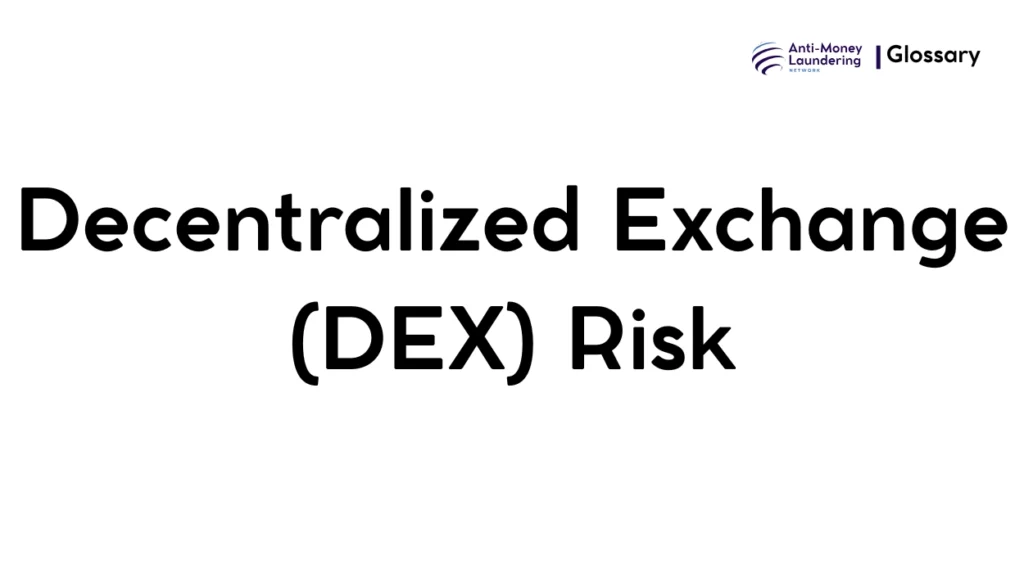Definition
Decentralized Exchange (DEX) Risk refers specifically to the anti-money laundering (AML) challenges and vulnerabilities that arise from the use of decentralized exchanges—blockchain-based platforms enabling peer-to-peer crypto asset trading without central intermediaries. Due to their non-custodial, pseudonymous, and borderless nature, DEXs can be exploited to obscure the origin and flow of illicit funds, complicating AML efforts.
Purpose and Regulatory Basis
DEX risk is a critical concern in AML compliance because these platforms can facilitate money laundering, terrorist financing, and other illicit financial flows. Global and national regulatory frameworks emphasize managing these risks to protect financial systems:
- Financial Action Task Force (FATF): Sets international standards that include the Virtual Asset Service Provider (VASP) Guidance applying to crypto exchanges.
- USA PATRIOT Act: Requires anti-money laundering programs and customer identification procedures for financial institutions, applied increasingly to crypto entities.
- EU Anti-Money Laundering Directives (AMLD): Expand AML obligations to virtual asset service providers, including exchanges.
Regulators focus on transparency, customer due diligence, transaction monitoring, and reporting suspicious activity to mitigate DEX risks.
When and How it Applies
DEX risk becomes relevant whenever a financial institution or compliance entity interacts with or monitors transactions involving decentralized exchanges. Common use cases include:
- Customers executing crypto-to-crypto trades through a DEX to layer or obfuscate funds.
- Cross-border transfers that evade traditional AML controls due to the absence of centralized oversight.
- Transactions involving mixing or tumbling services combined with DEX trades to hide illicit money origins.
Triggers for heightened scrutiny include unusually large or rapid transactions across multiple DEXs, the use of certain privacy-enhancing utilities, and addresses linked to illicit activity.
Types or Variants
DEXs vary based on architecture and liquidity model:
- Automated Market Maker (AMM) DEXs: Use liquidity pools and smart contracts for direct token swaps without order books (e.g., Uniswap).
- Order Book DEXs: Mimic traditional exchange order books but remain decentralized.
- Hybrid Models: Combine centralized features with decentralized protocols.
Each type presents distinct AML monitoring challenges, with AMMs usually creating dynamic price and liquidity conditions that complicate tracing.
Procedures and Implementation
Financial institutions should adopt tailored AML programs addressing DEX risks, including:
- Risk Assessment: Continuously evaluate customer exposure to DEX transactions.
- Customer Due Diligence (CDD): Verify identity and source of funds even when DEX usage is involved.
- Transaction Monitoring Systems: Employ blockchain analytics and pattern recognition tools that flag suspicious activity on DEXs.
- Enhanced Due Diligence (EDD): For transactions with high-risk indicators or exposure to privacy protocols.
- Training and Policies: Educate compliance staff on DEX technologies and related risks.
Impact on Customers/Clients
From a client’s perspective, AML controls tied to DEX risk can mean increased scrutiny and potential restrictions:
- Mandatory identity verification and KYC checks before engaging in DEX-related services.
- Monitoring or delays on large or complex transactions involving decentralized platforms.
- Possible restrictions or refusals of service where insufficient transparency or risk is detected.
Clients may perceive these as limitations but they align with regulatory and security requirements.
Duration, Review, and Resolution
AML obligations around DEX exposures are ongoing, requiring:
- Continuous Monitoring: Regular transaction and risk reviews.
- Periodic Audits: Assess internal controls and compliance effectiveness.
- Case Management: Prompt investigation and resolution of suspicious activities involving DEXs.
Institutions must adapt as the decentralized finance environment evolves.
Reporting and Compliance Duties
Institutions must:
- Report suspicious transactions to relevant financial intelligence units (FIUs), especially where DEX involvement indicates money laundering.
- Document all AML procedures, risk assessments, due diligence efforts, and monitoring results related to DEX activities.
- Ensure compliance with regional and global AML laws to avoid penalties—including significant fines or legal sanctions.
Related AML Terms
DEX risk intersects with other AML concepts like:
- DeFi Risks: Broader decentralized finance risks including lending, staking, and derivatives.
- Layering: A money laundering phase involving complex transaction layering often done using DEXs.
- KYC (Know Your Customer): Vital in addressing AML risks though often limited in pure DEX environments.
- Virtual Asset Service Providers (VASPs): Regulatory category often applied to entities interfacing with DEXs.
Challenges and Best Practices
Challenges
- Pseudonymity: User identity is often hidden behind wallet addresses.
- Lack of Central Control: No operator to enforce AML policies directly.
- Cross-Jurisdictional Issues: Global DEX usage complicates regulatory enforcement.
- Rapid Innovation: Constant technological changes outpace regulatory responses.
Best Practices
- Utilize advanced blockchain analytic tools.
- Collaborate with regulators and industry groups.
- Implement dynamic risk scoring models.
- Encourage partial KYC integration where technically feasible.
Recent Developments
AML approaches to DEXs are evolving due to:
- Regulatory pressure for travel rule compliance extending to decentralized platforms.
- Tech advancements improving traceability despite decentralization.
- Emergence of regulated “hybrid” DEX models incorporating KYC and AML compliance.
- Increased use of AI and machine learning for transaction monitoring.
Decentralized Exchange (DEX) Risk in AML represents a significant frontier in financial crime prevention. The unique features of DEXs challenge traditional AML frameworks but also drive innovation in compliance approaches. Financial institutions and regulators must collaborate and equip themselves with advanced tools and adaptable policies to address these risks effectively, safeguarding the financial system while enabling innovation.

